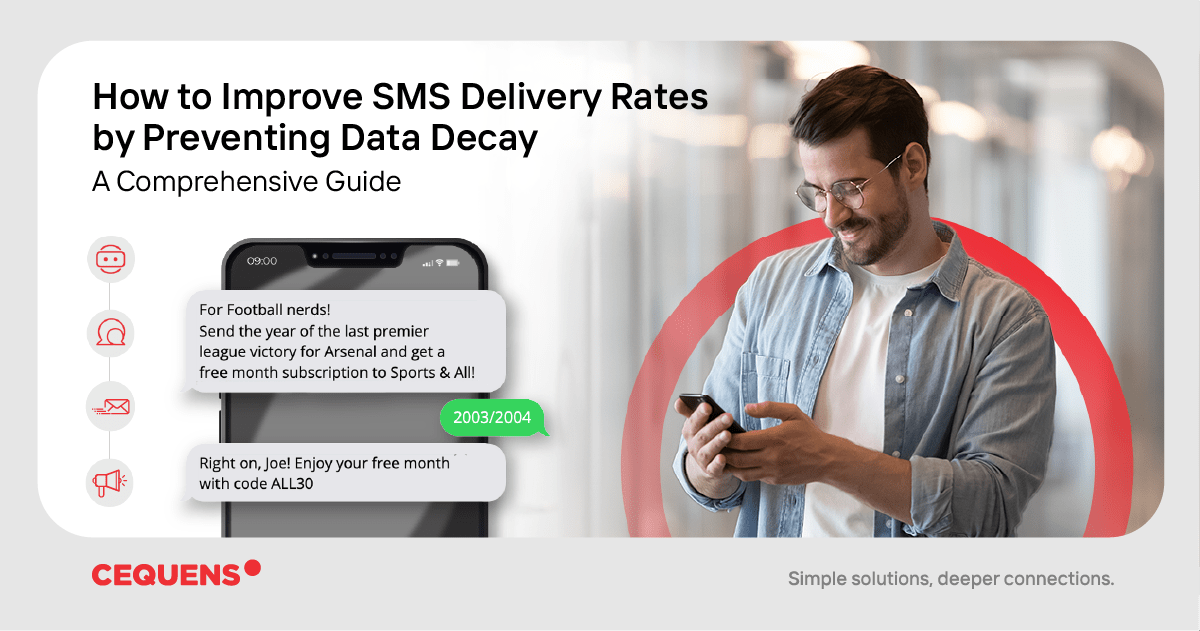SMS stands firmly as one of the most efficient business communication tools for marketing campaigns, sending OTPs and verification codes, reminders, announcements, and many more uses that are essential for all businesses. As consumers become more and more dependent on their phones, SMS remains as efficient as ever due to its high open rate which is 98% compared to 28% for email marketing in 2023. With the ability to connect to 7.33 billion mobile users around the world, businesses adopting smarter SMS tactics should have better opportunities of growth.
It is worth noting that sometimes business text messages stop getting through to their customers when there are thousands of numbers in its database, which can lower deliverability rates for your business. Making sure you have the updated mobile numbers for all your customers is important to ensure delivering a successful SMS campaign. However, in time, some numbers will surely become inactive or inaccurate. This is called data decay.
What causes data decay?
Data decay simply describes the process through which information becomes old and outdated. The larger your customer database gets, the more likely your business might encounter data decay. It can happen for multiple reasons such as when a user changes their phone number and it doesn’t get ported through different operators. At some point, you’re bound to have thousands of these incidents happening, and it’s important to keep your database cleaned and updated through number lookup services in order to maintain efficient and cost-effective SMS marketing.
How to prevent data decay?
Keeping track of customer data is invaluable, and preventing data decay is critical. Recent Gartner research has found that organizations believe poor data quality to be responsible for an average of $15 million per year in losses. Here are easy ways to prevent data decay:
- Frequent audience engagement: If you’re sending out constant updates and promotions to your customers, it will keep them more engaged. This maximizes your chances of collecting their updated information on a regular basis. It also helps you keep track of failed deliveries periodically.
- Make it easy for customers to update their information: Provide clear and easy-to-find instructions on how to update customer information. You can make it easy for customers to update their information by providing a self-service portal.
- Use data verification/cleansing tools: Data verification tools can help you identify and correct inaccurate data. There are several different data verification tools available, so you can choose the one that best fits the needs of your business.
What happens if you couldn’t prevent data decay in time?
Customer data deteriorates at a rate of 30% each year, meaning that nearly one-third of your customer data is inaccurate or outdated within a year. B2B data may decay even more ferociously. So, while some types of decay may be mechanical (occurring due to unforeseen circumstances such as servers crashing, corrupted disks, and other forms of damage), most of the decay is logical, it happens only when customers don’t update their contact information. It can also occur due to misspellings, either on the customer’s end or during manual data entry by the employee, which makes it very difficult to spot.
The negative impact of decaying data includes:
- Ineffective marketing campaigns: If your customer data is inaccurate, you won't be able to target your marketing campaigns effectively. This can result in wasted marketing spend and decreased customer engagement, such as higher bounce rates and lower open rates.
- Poor customer service: If you don't have accurate customer data, you won't be able to provide the best possible customer service. This can lead to customer frustration and churn.
- Fraud: Inaccurate data can also make it easier for fraudsters to steal customer identities.
To deal with the inevitability of data decay, you must go through multiple processes, including:
- Deduplication
- Contact verification
- Address cleaning
- Data security
When it comes to SMS specifically, using number lookup APIs to check for mobile number portability will significantly decrease the number of undelivered messages and reduce costs by verifying the validity and operational status of every number in your database before you start engaging with customers.
Below is a concise comparison between MNP Lookup and Realtime HLR for SMS deliverability:
| MNP Lookup |
Realtime HLR |
- Stands for Mobile Number Portability Lookup.
- Obtains information on the number’s home network.
- Identifies mobile network code, country code, and porting status.
- Validates customer data and cleanses CRM databases.
|
- Stands for Realtime Home Location Register.
- Obtains live information on any phone number.
- Revels real-time number validity, status, portability, and roaming status.
- Empowers adaptive routing to ensure successful delivery.
|
In a nutshell, businesses who invest in intelligent, data-driven communication solutions are more likely to retain their current customers and earn new ones through maintaining data hygiene and ensuring the highest campaign performance.


